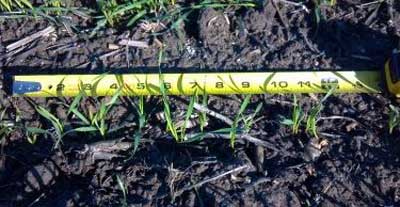Opportunities for wheat producers this fall
Before wheat is put to bed for the winter, there are a few things growers can do to insure a profitable enterprise.
To date, the majority of Michigan’s winter wheat has been planted. Wheat planted early (timely) emerged within several days and looks promising. Plantings made during the second and third week of October are slowly emerging. Regardless of when the wheat is planted, there is still time to take some management steps before the crop is blanketed with snow.
Report acreage
The final date to certify your planted acreage of wheat and other fall-seeded and perennial crops is Nov. 15, so growers should remember to make an appointment with the USDA Farm Service Agency (FSA) to complete the report before going off to deer camp. Annual certification of crops is required to participate in many USDA FSA programs.
Check stored wheat
As a reminder from Michigan State University Extension, storing wheat is not as easy as storing corn or soybeans. Wheat requires more attention as it is more resistant to airflow and is much more likely to be threatened by insect pests. Growers must remember to cool the stored crop as soon as possible and regularly monitor for temperature and insects.
Marketing the crop
Wheat might well be a more interesting grain commodity to watch in the months to come. Creating and following a marketing plan and simply staying in touch with one’s marketer is an obvious, yet worthy, reminder.
Assess new wheat stands
The level of success in stand establishment often translates into the difference between a good crop and a great crop of wheat. So, once wheat fully emerges, it’s a worthwhile exercise to make specific observations. For example, counting seedlings in the row can give a sense of how closely the actual seeding rate was to the intended rate, and observing the uniformity of plant density and time of emergence and then relating them to any deficiencies in land preparation or residue management.

Assessing seedling stands relative to populations and uniformity can often help explain the difference between an eventual “good” crop versus a “great” crop.
Planning for 2014
At this juncture, it appears there may be at least two separate wheat crops next season – one that was planted in a timely fashion and achieved significant fall growth, and another where almost no fall growth occurred. Accepting that the yield potential of the two may be 20 bushels or so, growers might consider being more generous with various inputs on the higher yield potential crop than with the more modest fields. For example, investing in more nitrogen fertilizer and fungicides on the high-yielding fields will likely be considerably more profitable than on the late planted fields.
Late planting
There is about 10 percent of the crop yet to be planted as of Oct. 28, according to the NASS report on Oct 8. 2013. Nevertheless, some growers will choose to plant in early November. When seeding this late, growers might consider being conservative with inputs, developing back-up plans if wheat fails to regrow next spring and increasing seeding rate to at least 2.2 million seeds per acre, dropping at least 32 seeds per foot of row in the hope of attaining at least 24 seedlings.
For more information
- Wheat and Barley Storage, University of Minnesota
- Storing Wheat, Kansas State University
- Still have winter wheat to get in the ground?, Michigan State University Extension



 Print
Print Email
Email